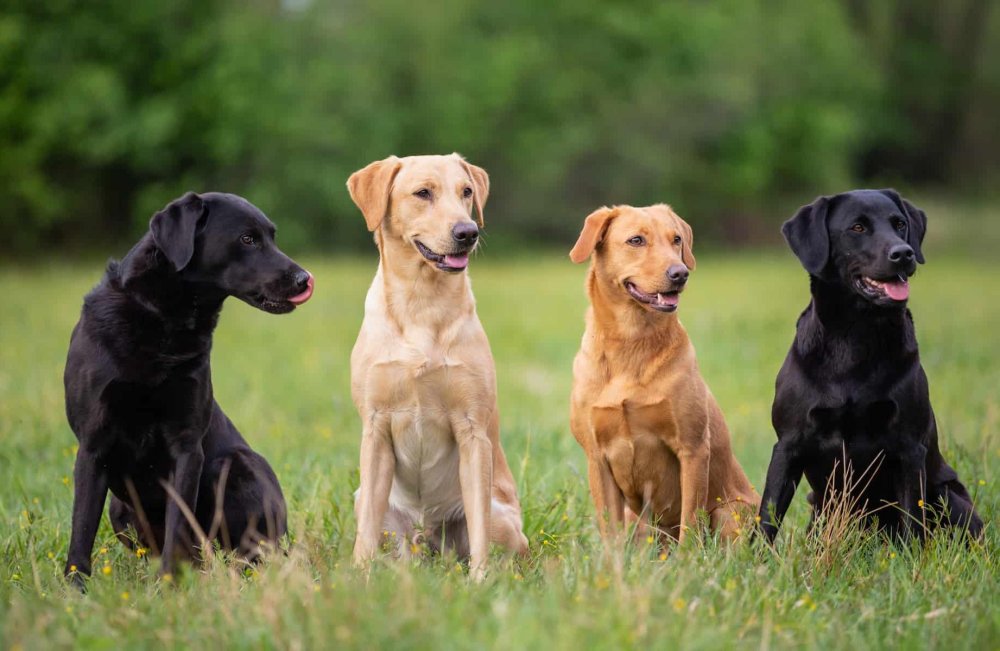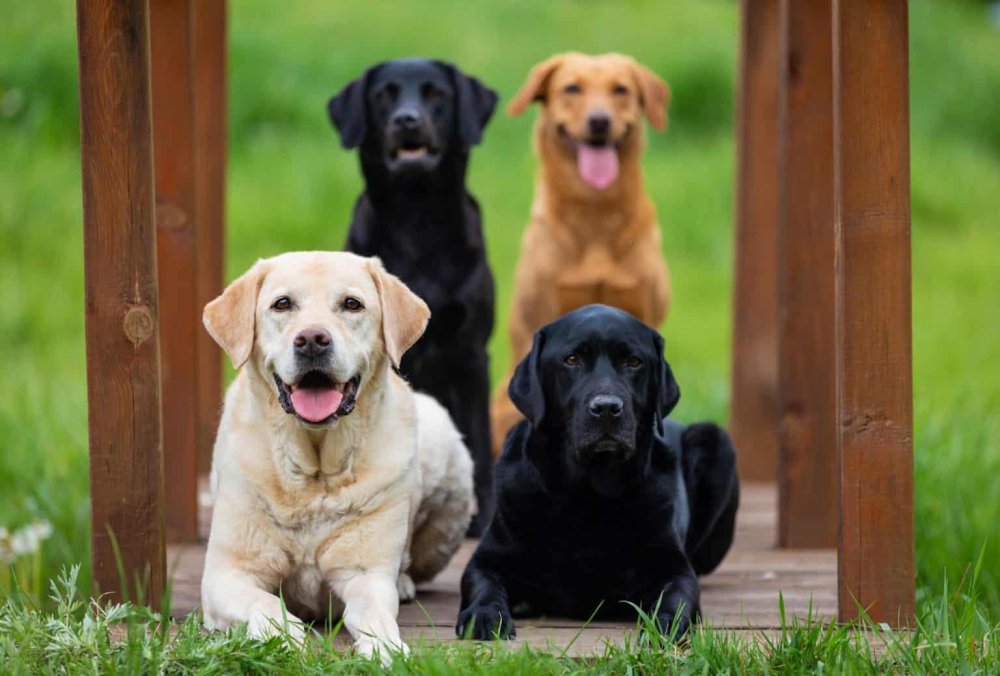- Breed Category: Gundog
- Country of Origin: Canada
- Average Height: Males 57-62 cm, Females 55-60 cm
- Average Weight: Males 29-36 kg, Females 25-32 kg
- Average Life Span: 10-12 years
- Grooming Requirements: Moderate, regular brushing needed
- Exercise Requirements: High, needs daily exercise
- Coat Type: Short, dense, water-resistant
- Coat Color Variations: Black, yellow, chocolate
- Shedding Level: Moderate to high
- Ear Type: Floppy
- Tail Type: Otter-like, thick at base
- Temperament: Friendly, outgoing, gentle
- Intelligence Level: High, quick learners
- Barking Tendency: Low to moderate
- Compatibility with Children: Excellent, very child-friendly
- Compatibility with Other Pets: Generally good
- Training Ease: Easy, eager to please
- Common Health Issues: Hip dysplasia, obesity, ear infections
- Dietary Needs: Balanced diet, prone to obesity
- Energy Level: High, very active
- Drooling Tendency: Low
- Sensitivity to Weather: Tolerant, but prefers moderate climates
- Overall Maintenance Level: Moderate
- Original Purpose: Retrieving game, waterfowl hunting
- Year of Recognition by Kennel Clubs: 1903
- Famous Breed Representatives: Marley from “Marley & Me”
- Apartment Friendly: Not ideal, needs space
- Best Suited For: Active families, outdoor enthusiasts
- Cost of Ownership: Moderate to high
- Unique Traits: Excellent swimmers, gentle mouth
- Cultural Significance: Popular in media and therapy work
- Popularity Rank: Consistently top-ranked worldwide
Imagine a dog that’s as friendly as it is loyal, with a playful spirit that never seems to fade. That’s the Labrador Retriever for you. Known for their intelligence and gentle nature, these dogs have captured the hearts of many around the world. Originally bred in Newfoundland, Canada, they were used by fishermen to retrieve nets and catch fish that escaped. Today, they’re one of the most popular breeds, cherished for their versatility and companionship. This article will dive into what makes Labradors so special, exploring their unique characteristics, rich history, and the best ways to care for them. Whether you’re considering bringing one home or just curious, you’ll find everything you need to know right here.
History and Origin of the Labrador Retriever

Early Development of the Breed
The Labrador Retriever’s journey began in the early 19th century on the island of Newfoundland, Canada. Originally known as the St. John’s dog, these early Labradors were smaller and had a dense, water-resistant coat. They were bred by local fishermen who needed a reliable partner to help with their daily tasks. Over time, these dogs were brought to England, where they were further developed into the breed we know today.
Role in Hunting and Retrieving
Labradors quickly gained a reputation for their exceptional retrieving skills. Their natural affinity for water and strong swimming ability made them perfect for retrieving game from both land and water. Hunters valued them for their keen sense of smell and gentle mouth, which allowed them to retrieve game without damaging it. This versatility cemented their role as a favourite among hunters.
Key Historical Figures
One of the pivotal figures in the development of the Labrador Retriever was the 2nd Earl of Malmesbury. He was instrumental in refining the breed’s characteristics, focusing on their retrieving abilities. His dedication to breeding these dogs for hunting purposes played a significant role in shaping the modern Labrador Retriever.
Physical Characteristics of the Labrador Retriever

Appearance
Labrador Retrievers are medium to large-sized dogs, typically weighing between 25 to 36 kilograms. They have a strong, athletic build that’s both powerful and agile. Their coat is short, dense, and water-resistant, coming in three standard colours: black, yellow, and chocolate. Each colour has its own charm, but all Labradors share a sleek, shiny coat that’s easy to maintain. Distinctive markings are rare, but some may have a small white spot on their chest.
Unique Physical Traits
One of the most notable features of the Labrador is their otter-like tail. This thick, tapering tail acts as a rudder when they swim, helping them navigate through water with ease. Their webbed feet are another adaptation for swimming, making them excellent water retrievers. Labradors also have a broad head and expressive eyes that give them a friendly, intelligent appearance, capturing the hearts of many dog lovers.
Temperament and Behaviour of the Labrador Retriever

Typical Personality Traits
Labrador Retrievers are known for their friendly and outgoing nature. They are incredibly social dogs, often getting along well with both humans and other animals. Their intelligence is another standout trait, making them highly trainable and eager to please. This combination of smarts and sociability makes them a joy to have around.
Suitability as a Family Pet and Working Dog
These dogs are versatile, fitting seamlessly into family life while also excelling in working roles. Their gentle disposition and patience make them ideal companions for families with children. As working dogs, they shine in roles such as guide dogs, search and rescue, and therapy work, thanks to their keen senses and adaptability.
Interaction with Children and Other Animals
Labradors are generally great with kids, often forming strong bonds and enjoying playtime. Their gentle nature means they’re usually tolerant and patient, even with the most energetic children. When it comes to other animals, Labradors are typically friendly and non-aggressive, making them a good fit for multi-pet households.
Training and Exercise Needs of the Labrador Retriever

Importance of Early Training and Socialisation
Getting a Labrador off to a good start with early training and socialisation is crucial. These dogs are naturally friendly, but introducing them to different environments, people, and other animals early on helps them grow into well-rounded adults. It’s all about setting the foundation for a confident and adaptable dog.
Recommended Training Techniques
Labradors are smart and eager to please, making them a joy to train. Positive reinforcement techniques work wonders with this breed. Think treats, praise, and playtime as rewards. Consistency is key, so keep training sessions regular and engaging. Short, fun sessions are more effective than long, tedious ones.
Daily Exercise Requirements and Activities They Enjoy
Labradors are energetic and need plenty of exercise to stay happy and healthy. Aim for at least an hour of physical activity each day. They love activities like swimming, fetch, and long walks. Mental stimulation is just as important, so mix in some puzzle toys or training games to keep their minds sharp.
Health and Lifespan of the Labrador Retriever

Common Health Issues
Labrador Retrievers are generally healthy, but like all breeds, they’re prone to certain health conditions. Hip and elbow dysplasia are common, which can lead to arthritis if not managed properly. They may also face eye conditions like progressive retinal atrophy and cataracts. Obesity is another concern, as Labradors love their food, so keeping an eye on their diet is crucial.
Average Lifespan and Health Tips
On average, Labradors live between 10 to 12 years. To help them reach a ripe old age, regular exercise and a balanced diet are key. Keep their weight in check and provide plenty of mental stimulation to keep them sharp. Regular vet check-ups are essential to catch any potential issues early.
Preventative Care Recommendations
- Schedule annual vet visits for comprehensive health checks.
- Maintain a healthy diet and monitor portion sizes to prevent obesity.
- Ensure regular exercise to keep joints healthy and weight under control.
- Brush their teeth regularly to prevent dental issues.
- Keep up with vaccinations and parasite control to protect against common diseases.
Grooming and Maintenance of the Labrador Retriever

Coat Care and Grooming Routines
Labradors have a short, dense coat that’s surprisingly easy to maintain. Regular brushing, about once a week, helps keep their coat looking sleek and shiny. It also reduces the amount of hair around your home. A good quality bristle brush or a grooming mitt works wonders. Bathing should be occasional, only when they get particularly dirty, as over-bathing can strip their coat of natural oils.
Shedding and Seasonal Grooming Tips
Labradors are known to shed quite a bit, especially during the change of seasons. During these times, you might want to increase brushing to a few times a week. This helps manage the shedding and keeps their coat healthy. A de-shedding tool can be particularly useful during these periods. Regular grooming not only keeps your Labrador looking their best but also provides an opportunity to check for any skin issues or parasites.
Diet and Nutrition for the Labrador Retriever

Nutritional Needs for Optimal Health
Feeding your Labrador the right diet is crucial for their health and happiness. These dogs need a balanced diet rich in proteins, healthy fats, and carbohydrates. Proteins support muscle development, while fats provide energy and help maintain a shiny coat. Carbohydrates are essential for energy, especially for such an active breed.
Foods to Include and Avoid
Include high-quality dog food with real meat as the first ingredient. Fish, chicken, and lamb are excellent protein sources. Add some vegetables and fruits for vitamins and minerals. Avoid foods with artificial additives, fillers, and excessive grains. Chocolate, onions, and grapes are toxic to dogs, so keep them out of reach.
Feeding Schedules and Portion Recommendations
Stick to a regular feeding schedule to maintain a healthy weight. Adult Labradors typically do well with two meals a day. Puppies may need three to four smaller meals. Portion sizes depend on their age, weight, and activity level, so consult your vet for personalised advice. Always provide fresh water alongside meals.
Fun Facts and Trivia about Labrador Retrievers

Interesting Tidbits about the Breed
Labrador Retrievers are not just popular pets; they hold a special place in history and culture. Did you know that they were originally called St. John’s dogs? Their name changed when they were brought to England and further developed into the breed we know today. Labradors are also known for their love of water, thanks to their webbed feet and water-resistant coat, making them natural swimmers.
Famous Labrador Retrievers in Media or History
These lovable dogs have made their mark in media and history. One of the most famous Labradors was “Buddy,” the beloved pet of former U.S. President Bill Clinton. In the world of cinema, Labradors have starred in movies like “Marley & Me,” capturing hearts with their playful antics and loyal nature. Their intelligence and trainability have also made them stars in various TV shows and commercials, showcasing their versatility and charm.
Final Thoughts

Labrador Retrievers embody the perfect blend of loyalty and versatility. Their friendly nature and intelligence make them ideal companions for families and working roles alike. While they require regular exercise and mindful care, the rewards of having a Labrador are immeasurable, from their unwavering companionship to their playful spirit. As you consider welcoming a Labrador into your life, remember the joy and enrichment they bring, and prepare to embark on a fulfilling journey together. Embrace the opportunity to create lasting memories with this beloved breed.
